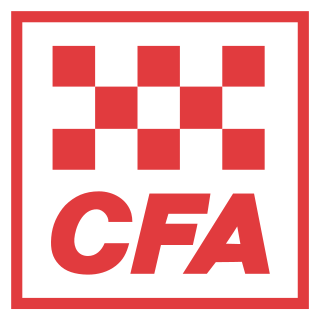
The Black Friday bushfires of 13 January 1939, in Victoria, Australia, were part of the devastating 1938–1939 bushfire season in Australia, which saw bushfires burning for the whole summer, and ash falling as far away as New Zealand. It was calculated that three-quarters of the State of Victoria was directly or indirectly affected by the disaster, while other Australian states and the Australian Capital Territory were also badly hit by fires and extreme heat. As of 3 November 2011, the event was one of the worst recorded bushfires in Australia, and the third most deadly.

The Ash Wednesday bushfires, known in South Australia as Ash Wednesday II, were a series of bushfires that occurred in south-eastern Australia on 16 February 1983, which was Ash Wednesday. Within twelve hours, more than 180 fires fanned by hot winds of up to 110 km/h (68 mph) caused widespread destruction across the states of Victoria and South Australia. Years of severe drought and extreme weather combined to create one of Australia's worst fire days in a century. The fires were the deadliest bushfire in Australian history until the Black Saturday bushfires in 2009.

The Country Fire Authority (CFA) is a volunteer fire service responsible for fire suppression, rescues, and response to other accidents and hazards across most of the state Victoria, Australia. CFA comprises over 1,200 brigades organised in 21 districts, and shares responsibility for fire services with Fire Rescue Victoria (FRV), which employs full-time paid firefighters in major urban areas; and Forest Fire Management Victoria (FFMV), which manages fire prevention and suppression on Victoria's public lands. CFA operations and equipment are partly funded by the Victorian Government through its Fire Services Levy, and supplemented by individual brigades' fundraising for vehicles and equipment.

International Firefighters' Day (IFFD) is observed on May 4. It was established after a proposal was made on January 4, 1999, following the deaths of five firefighters fighting a bushfire in Australia on 2 December, 1998. It is also a day to commemorate firefighters killed in the September 11 attacks.

Linton is a town in Victoria, Australia, off Glenelg Highway. Most of the town is located in Golden Plains Shire; however, a small section is in the Shire of Pyrenees. At the 2016 census, Linton and the surrounding area had a population of 580. The Clarkesdale Bird Sanctuary lies to the south-east of the township, near Springdallah Creek.
In Australia, the Australasian Inter-Service Incident Management System (AIIMS) is the nationally recognised system of incident management for the nation's fire and emergency service agencies. Organisational principles and structure are used to manage bushfires and other large emergencies utilising the all agencies approach. AIIMS was first developed by the Forests Commission Victoria (FCV) in wake of the Ash Wednesday Bushfires in 1983 as a derivative of the United States’ NIMS, and is based on the principles of management by objectives, functional management, common terminology and limits to the span of control. AIIMS is a trademark of AFAC and the material in the AIIMS manual and training materials is copyright of AFAC.

The Eyre Peninsula bushfire of 2005, an event also known locally as Black Tuesday and by South Australian Government agencies as the Wangary bushfire, was a bushfire that occurred during January 2005 on the lower part of the Eyre Peninsula, a significant part of South Australia's wheat belt, where most of the land is either cropped or grazed. The fire resulted in 780 square kilometres (301 sq mi) of land being burnt, the loss of nine lives, injury to another 115 people, and huge property damage. It was South Australia's worst bushfire since the Ash Wednesday fires of 1983. Heat from the fire reached 1,000 °C (1,830 °F), with speeds up to 100 kilometres per hour (62 mph).

A moderately extensive bushfire season, particularly in western Victoria where fires were most prominent, occurred in mid-late January 2006 as conditions persisted across the state.

A particularly extensive bushfire season in Australia, ran predominantly from December 2002 to March 2003 and involved over 3,000 separate fires in Victoria alone. The 2003 Canberra bushfires were also particularly severe.

The state of Victoria in Australia has had a long history of catastrophic bushfires, the most deadly of these, the Black Saturday bushfires of 2009 claiming 173 lives. Legislation, planning, management and suppression are the responsibilities of the Victorian State Government through its departments and agencies including the Country Fire Authority (CFA) and the Department of Environment, Land, Water and Planning (DELWP).

Bushfires in Australia are a widespread and regular occurrence that have contributed significantly to shaping the nature of the continent over millions of years. Eastern Australia is one of the most fire-prone regions of the world, and its predominant eucalyptus forests have evolved to thrive on the phenomenon of bushfire. However, the fires can cause significant property damage and loss of both human and animal life. Bushfires have killed approximately 800 people in Australia since 1851, and billions of animals.

The Black Saturday bushfires were a series of bushfires that either ignited or were already burning across the Australian state of Victoria on and around Saturday, 7 February 2009, and were among Australia's all-time worst bushfire disasters. The fires occurred during extreme bushfire weather conditions and resulted in Australia's highest-ever loss of human life from a bushfire, with 173 fatalities. Many people were left homeless as a result.

The 1943–44 Victorian bushfire season was marked by a series of major bushfires following severe drought conditions in the state of Victoria in Australia. The summer of 1943–44 was the driest summer ever recorded in Melbourne with just 46 mm falling, a third of the average for the period. Between 22 December and 15 February 51 people were killed, 700 injured, and 650 buildings were destroyed across the state. Many personnel who would have been normally available for fire fighting duties had been posted overseas and to remote areas of Australia during World War II.

The Penhallow Hotel fire was a suspected arson attack that occurred in Newquay, Cornwall on 18 August 2007. Three people were killed and it was reported as the worst hotel fire in the United Kingdom in nearly 40 years. The hotel was a well-known hotel for holiday makers ranging from families to older residents. It had been built in Island Crescent between 1912 and 1917, and had been altered more than once. The building had a wooden fire escape at the rear, and a central light shaft running from the ground floor up to the roof in the centre of the hotel. Both of these aspects of the building played a dramatic role in the outcome of the fire. Many of those that escaped the fire were elderly holiday makers.

The Newham Fire Brigade is a volunteer firefighting service located in Newham, Victoria at 1293 Rochford Road. The brigade is often referred to as the Newham CFA and was formerly known as the Newham Rural Fire Brigade. The brigade is part of the Mount Macedon Group in the Lodden-Mallee Region of the Country Fire Authority. Newham is located in the Macedon Ranges, which is one of Victoria's popular holiday spots and has a risk of bushfire during the summer months.

The summer of 2012–13 had above average fire potential for most of the southern half of the continent from the east coast to the west. This is despite having extensive fire in parts of the country over the last 12 months. The reason for this prediction is the abundant grass growth spurred by two La Niña events over the last two years.

The most destructive bushfire season in terms of property loss since the 2008–09 Australian bushfire season, occurred in the summer of 2015–16, with the loss of 408 houses and at least 500 non-residential buildings as a result of wild fires between 1 June 2015 and 31 May 2016. The season also suffered the most human fatalities since the 2008–09 Australian bushfire season; 6 died in Western Australia, 2 in South Australia and 1 in New South Wales. 8 deaths were as a direct result of fire, and a volunteer firefighter died due to unrelated health complications while on duty.

Fire Rescue Victoria (FRV) is a fire and rescue service in the state of Victoria, Australia, that provides firefighting, rescue, HAZMAT and Emergency Medical Response services in areas of metropolitan Melbourne and major regional centres throughout Victoria.















